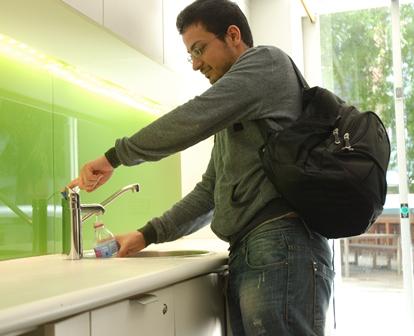Water
UTS has an ambitious water saving target to reduce consumption each and every year. Since 2002 consumption has been cut 26%, despite a significant increase in floor space and student and staff numbers. The Water Management Plan 2019 - 2021 outlines our management approach, targets, and progress to date.
Water efficiency
We have an ongoing program of water saving initiatives including, so far:
- Dual flush toilets in new and refurbished bathrooms
- Waterless urinals
- Tap aerators and automatic taps in bathrooms, kitchens and labs
- Water efficient appliances in kitchens, bathrooms and labs
- New air-conditioning technology that uses less water
- Mechanically driven vacuum aspiration in labs replacing water driven systems
- New web-based water management system
- ‘Smart’ meters and alarm systems to better detect leaks
Landscaping to capture rainwater, and minimise water consumption.
The UTS Design Guidelines apply building standards across the campus to minimise water use.

What you can do
- Only put the dishwasher on when its full
- Don’t rinse dishes before putting them in the dishwasher, and if absolutely necessary do it in a plugged sink
- Report leaking taps, toilets, urinals and any other leaks to Building Services.
- Limit showers to four minutes or less
- Never leave taps running
Waste water management
We capture stormwater from building roof tops which is stored in tanks, treated and re-used on campus. The tanks are located in the Dr Chau Chak Wing building (Building 8), the Faculty of Engineering and IT building (Building 11), the Ross Milbourne Sports Hall (in Building 4) and underneath Alumni Green (serving the Vicki Sara building; Building 7). The captured water is filtered and treated using ultraviolet light irradiation (UV). The recycled water is then used for toilet flushing and landscape irrigation in those buildings. The UTS Haberfield Rowing Club has a waste water recycling system where stormwater is collected from the roof, stored in a tank, treated and re-used, mostly for washing down boats. Water is also reused from the cooling tower bleed (waste) water in Buildings 1 and 11.
Recycled water meters have been installed to the stormwater tanks in Buildings 7 and 8 to measure recycled water use. These meters can be viewed centrally on the campus-wide EMS (Energy Management System). UTS, as a member of the City of Sydney Council’s Better Buildings Partnership (BBP), contributed to the development of BBP Connection Guidelines for Recycled Water.
Water pollution prevention
UTS has a number of green roofs and terraces (Buildings 2, 7, 10 and Alumni Green). One of the many benefits of green roofs is that they capture rainwater, filter it and slow its release to the city’s stormwater system, resulting in improved water quality and a cleaner discharge to natural waterways.
UTS has systems and procedures in place for the safe collection and disposal of hazardous waste, including processes to prevent pollution caused by accidents and incidents from entering waterways. Contractors complete induction training prior to commencing work on campus and major projects submit an Environmental Management Plan which outlines how pollution of the water system from soil run-off and hazardous materials will be prevented.
Sustainable water extraction
UTS does not extract any water from aquifers, lakes or rivers as this can have negative environmental impacts. Instead, UTS has a supply agreement with a Waste Water Recycling plant on an adjacent property off campus where recycled water (from stormwater and sewer mining) is extracted and supplied to UTS for landscape irrigation and toilet flushing.
